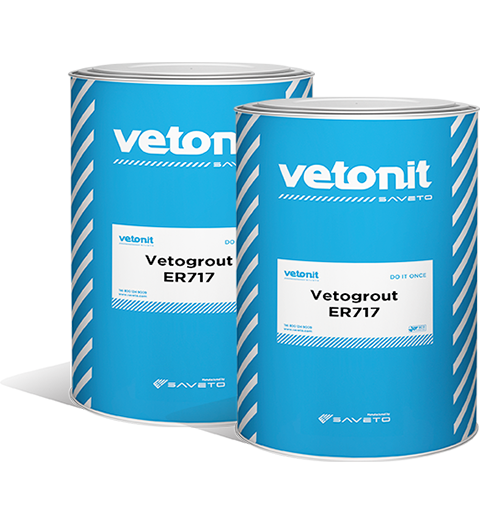Vetogrout ER717 - AE
Low viscosity epoxy grout & injection resin.
Vetogrout ER717 is a low viscosity epoxy resin-based grout for crack injection where the hardened grout’s chemical resistance and physical properties are of extreme importance (for example: extreme industrial applications, rail tracks, dynamic load situations, chemical tanks, etc.).
Vetogrout ER717 consists of two components (Base and Hardener) that are provided in the right proportions. When mixed and applied, it penetrates deep into cracks and cavities, providing a permanent seal.

Uses
- To restore structural integrity of structural elements.
- To inject structural elements in retaining walls, beams, columns, shear walls, tanks, etc.
- For grouting and static crack filling from 0.2 to 10 mm.
- For base plate grouting in dynamic load situations.
Advantages
- Used in a wide range of situations such as cyclic and dynamic load cases.
- It is highly durable, ensuring long working life with high mechanical properties such as compressive, flexural, and tensile strength.
- Cost-effective with rapid strength gain ensuring minimum structural downtime.
- Non-shrink and complete surface bonding providing a 100% effective bearing area.
- It withstands hydrostatic pressure and prohibits penetration of contaminants and aggressive chemicals.
Usage Instructions
The substrate must be free from oil, grease, or any loosely adherent material. If the concrete surface is defective or has laitance, it must be cut back to a sound base. Bolt holes or fixing pockets must be blown clean of any dirt or debris.
All cracks must be chased and open to a 2mm thickness (width generated by a saw blade).
Remove laitance and roughen 2 cm on each side of the crack using a hand grinder, then clean the surface and all cracks with compressed air.
Depending on the injection method (surface nipples or injection packers); the surface nipples on the crack face should be fixed using Vetorep ER350 (a twin-pack epoxy putty and leveling compound) before sealing the crack surface with Vetorep ER350. You can also seal the crack surface directly before drilling injection holes at 45-degree angles on the crack’s sides.
Pour the entire contents of the hardener container (B)into the base container (A) and mix for 2 - 3 minutes or until a uniform color is achieved. Once mixed, the material must be used within the specified pot life (20 minutes at 40 deg cel.)
After this time, unused material will have stiffened and should be discarded.
Note: All surfaces must be dried right before placement.
Mixed product should be applied with standard injecting equipment having closed containers. The injection pressure should be at least 3 bar. Use injecting packers which must be inserted into pre-drilled holes along the length of the crack. The distance between packers depends on the crack’s width and depth.
After fixing the packers, use epoxy mortar to seal between the packers to allow the resin to penetrate from point to the next.
For horizontal cracks pour the product directly.
For crack injection, it is recommended to assign the job to an injection specialist. In case of partial mixing, maintain the proportions in volume.
Use Vetonit Solvent XX400 to clean equipment before material begins to harden; otherwise, mechanical means will be necessary to remove hardened material.









